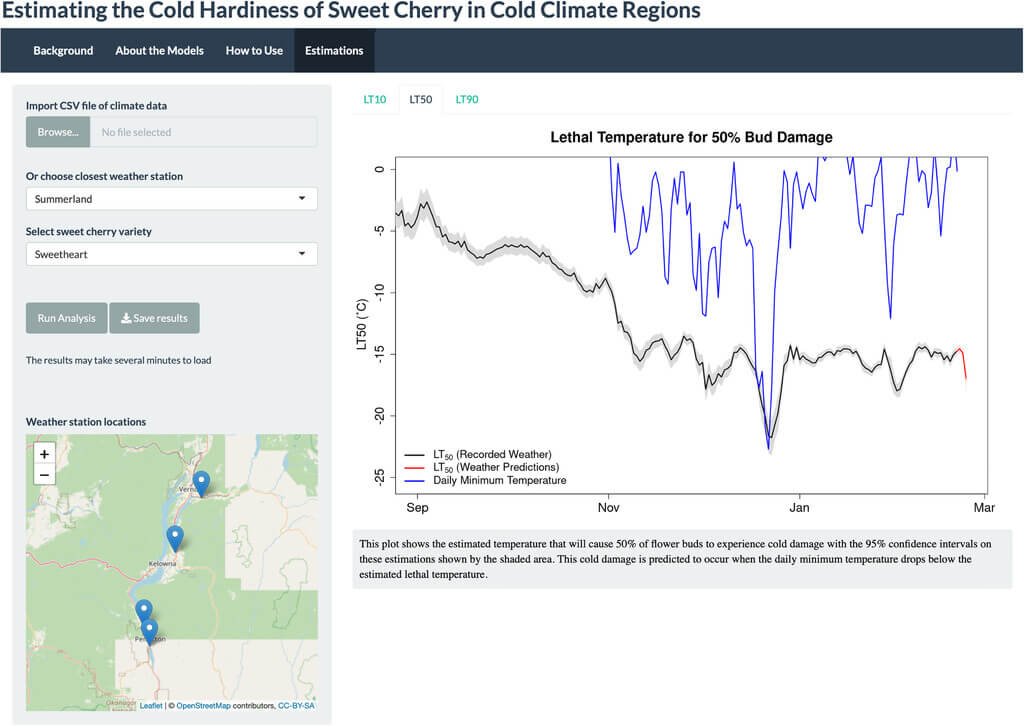The cold hardiness of plants is a dynamic phenomenon, characterised by seasonal fluctuations that involve the processes of cold acclimation and de-acclimation. These processes play a crucial role in mitigating the risk of fatal damage caused by low temperatures.
Insufficient cold tolerance of plants can lead to cold winter harm, which can have substantial financial implications for producers of perennial crops in temperate regions. The primary aim of the present investigation was to construct predictive models for determining the lethal temperature (LT) thresholds resulting in 10%, 50%, and 90% death rates (LT10, LT50, LT90) for two distinct cultivars of sweet cherry flower buds, during the autumn and winter period.
The regression models were parameterized using lethal temperature data obtained from the Okanagan Valley, located in British Columbia, Canada. The data was collected over a span of six seasons, specifically from 2013 to 2017, 2019 to 2020, and 2021 to 2022, for the 'Sweetheart' sweet cherry variety.
For the 'Lapins' sweet cherry variety, the data was collected over three seasons, namely 2013 to 2015 and 2016 to 2017. These models utilise characteristics derived from equations that characterise the accumulation of chill and heat, which are dependent on hourly air temperature measurements.
The process of evaluating and validating the model involved the utilisation of multiple seasons of fatal temperature data that were not incorporated during the initial creation of the model. The models utilised for evaluating the cold hardiness of sweet cherry demonstrated a satisfactory level of concurrence between the lethal temperature estimates generated by the models and the actual values for various sweet cherry cultivars.
One of the limitations of this study is the ongoing need for a more comprehensive knowledge of the course of spring cold hardiness. Thus, it would be advantageous to enhance these models in the future by using a greater resolution of LT data gathered specifically during the spring months.
Moreover, it is necessary to validate these models by utilising data gathered from places that go beyond the southern Okanagan Valley. This validation is crucial to ascertain the suitability and effectiveness of these models in a broader spectrum of geographical areas.
The models were made readily available to growers and academics using a freely accessible online web tool that included interactive features. Decision support tools can be utilised in making informed decisions regarding the implementation of strategies aimed at mitigating the adverse effects of cold damage.
 Figure 1: “Estimations” page of interactive web application designed for simplified and open-access to cold hardiness model estimations made from either user uploaded weather data or the current season’s data accessed from the Government of Canada’s Historic Climate database (https://climate.weather.gc.ca) and 3 d of weather forecasts from OpenWeather (https://openweathermap.org).
Figure 1: “Estimations” page of interactive web application designed for simplified and open-access to cold hardiness model estimations made from either user uploaded weather data or the current season’s data accessed from the Government of Canada’s Historic Climate database (https://climate.weather.gc.ca) and 3 d of weather forecasts from OpenWeather (https://openweathermap.org).
By utilising this decision support tool, growers can optimise the potential for winter cherry blossom bud survival and minimise financial losses caused by cold damage to crops. Moreover, these models have the potential to enhance resource optimisation by assisting producers in making informed decisions regarding the implementation of frost damage mitigation techniques, such as the utilisation of active frost prevention techniques only when necessary.
These models can also be utilised to assess production risk prior to the plantation of new orchards, by utilising historical temperature records. Additionally, they can contribute to enhancing our comprehension and modelling of the evolving suitability of sweet cherry crop sites, including both current conditions and projected future scenarios of climate change.
Fonte: Houghton, Elizabeth, Michael J. Noonan, Kirsten Hannam, Louise M. Nelson, and Denise Neilsen. "Models for Estimating the Cold Hardiness of Sweet Cherry (Prunus avium cv. Sweetheart and Lapins) in Cold Climate Regions". HortScience 58.9 (2023): 963-973, https://doi.org/10.21273/HORTSCI17128-23.
Melissa Venturi
University of Bologna (IT)
Cherry Times - All rights reserved











